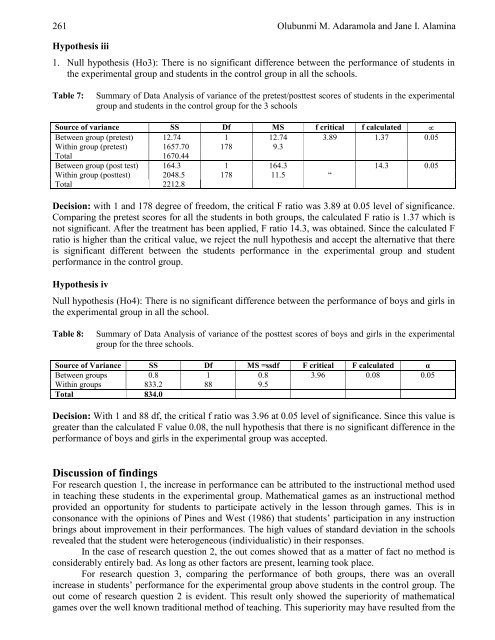European Journal of Scientific Research - EuroJournals
European Journal of Scientific Research - EuroJournals
European Journal of Scientific Research - EuroJournals
Create successful ePaper yourself
Turn your PDF publications into a flip-book with our unique Google optimized e-Paper software.
261 Olubunmi M. Adaramola and Jane I. Alamina<br />
Hypothesis iii<br />
1. Null hypothesis (Ho3): There is no significant difference between the performance <strong>of</strong> students in<br />
the experimental group and students in the control group in all the schools.<br />
Table 7: Summary <strong>of</strong> Data Analysis <strong>of</strong> variance <strong>of</strong> the pretest/posttest scores <strong>of</strong> students in the experimental<br />
group and students in the control group for the 3 schools<br />
Source <strong>of</strong> variance SS Df MS f critical f calculated ∝<br />
Between group (pretest) 12.74 1 12.74 3.89 1.37 0.05<br />
Within group (pretest) 1657.70 178 9.3<br />
Total 1670.44<br />
Between group (post test) 164.3 1 164.3 14.3 0.05<br />
Within group (posttest) 2048.5 178 11.5 “<br />
Total 2212.8<br />
Decision: with 1 and 178 degree <strong>of</strong> freedom, the critical F ratio was 3.89 at 0.05 level <strong>of</strong> significance.<br />
Comparing the pretest scores for all the students in both groups, the calculated F ratio is 1.37 which is<br />
not significant. After the treatment has been applied, F ratio 14.3, was obtained. Since the calculated F<br />
ratio is higher than the critical value, we reject the null hypothesis and accept the alternative that there<br />
is significant different between the students performance in the experimental group and student<br />
performance in the control group.<br />
Hypothesis iv<br />
Null hypothesis (Ho4): There is no significant difference between the performance <strong>of</strong> boys and girls in<br />
the experimental group in all the school.<br />
Table 8: Summary <strong>of</strong> Data Analysis <strong>of</strong> variance <strong>of</strong> the posttest scores <strong>of</strong> boys and girls in the experimental<br />
group for the three schools.<br />
Source <strong>of</strong> Variance SS Df MS =ssdf F critical F calculated �<br />
Between groups 0.8 1 0.8 3.96 0.08 0.05<br />
Within groups 833.2 88 9.5<br />
Total 834.0<br />
Decision: With 1 and 88 df, the critical f ratio was 3.96 at 0.05 level <strong>of</strong> significance. Since this value is<br />
greater than the calculated F value 0.08, the null hypothesis that there is no significant difference in the<br />
performance <strong>of</strong> boys and girls in the experimental group was accepted.<br />
Discussion <strong>of</strong> findings<br />
For research question 1, the increase in performance can be attributed to the instructional method used<br />
in teaching these students in the experimental group. Mathematical games as an instructional method<br />
provided an opportunity for students to participate actively in the lesson through games. This is in<br />
consonance with the opinions <strong>of</strong> Pines and West (1986) that students’ participation in any instruction<br />
brings about improvement in their performances. The high values <strong>of</strong> standard deviation in the schools<br />
revealed that the student were heterogeneous (individualistic) in their responses.<br />
In the case <strong>of</strong> research question 2, the out comes showed that as a matter <strong>of</strong> fact no method is<br />
considerably entirely bad. As long as other factors are present, learning took place.<br />
For research question 3, comparing the performance <strong>of</strong> both groups, there was an overall<br />
increase in students’ performance for the experimental group above students in the control group. The<br />
out come <strong>of</strong> research question 2 is evident. This result only showed the superiority <strong>of</strong> mathematical<br />
games over the well known traditional method <strong>of</strong> teaching. This superiority may have resulted from the

















